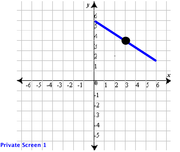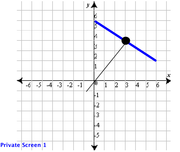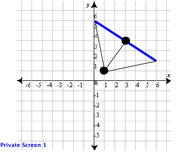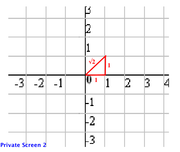If on the coordinate plane (6,2) and (0,6) are the endpoints of the diagonal of a square, what is the distance between point (0,0) and the closest vertex of the square?
1/√2
1
√2
√3
2√3
Let us discuss the alternative methods for this question.
If on the coordinate plane (6,2) and (0,6) are the endpoints
This topic has expert replies
- richachampion
- Legendary Member
- Posts: 698
- Joined: Tue Jul 21, 2015 12:12 am
- Location: Noida, India
- Thanked: 32 times
- Followed by:26 members
- GMAT Score:740
R I C H A,
My GMAT Journey: 470 → 720 → 740
Target Score: 760+
[email protected]
1. Press thanks if you like my solution.
2. Contact me if you are not improving. (No Free Lunch!)
My GMAT Journey: 470 → 720 → 740
Target Score: 760+
[email protected]
1. Press thanks if you like my solution.
2. Contact me if you are not improving. (No Free Lunch!)
- richachampion
- Legendary Member
- Posts: 698
- Joined: Tue Jul 21, 2015 12:12 am
- Location: Noida, India
- Thanked: 32 times
- Followed by:26 members
- GMAT Score:740
OA: C
R I C H A,
My GMAT Journey: 470 → 720 → 740
Target Score: 760+
[email protected]
1. Press thanks if you like my solution.
2. Contact me if you are not improving. (No Free Lunch!)
My GMAT Journey: 470 → 720 → 740
Target Score: 760+
[email protected]
1. Press thanks if you like my solution.
2. Contact me if you are not improving. (No Free Lunch!)
- GMATGuruNY
- GMAT Instructor
- Posts: 15539
- Joined: Tue May 25, 2010 12:04 pm
- Location: New York, NY
- Thanked: 13060 times
- Followed by:1906 members
- GMAT Score:790
The diagonals of a square bisect each other.richachampion wrote:If on the coordinate plane (6,2) and (0,6) are the endpoints of the diagonal of a square, what is the distance between point (0,0) and the closest vertex of the square?
1/√2
1
√2
√3
2√3
The point of intersection is equal to the MIDPOINT of each diagonal.
DRAW the given diagonal, along with its midpoint:

The diagonals of a square are perpendicular.
Draw a perpendicular line through the midpoint of the given diagonal:

In the figure above, the second diagonal seems to pass through (1,1).
Test whether (1,1) could be a vertex of the square, as follows:

If (1,1) is a vertex of the square, then the two sides of the square that intersect at (1,1) must be perpendicular.
The slopes of perpendicular lines are negative reciprocals.
Test whether (1,1) yields two sides whose slopes are negative reciprocals.
Slope of the side formed by (0,6) and (1,1) = (1-6)/(1-0) = -5.
Slope of the side formed by (6,2) and (1,1) = (1-2)/(1-6) = 1/5.
Success!
The resulting slopes are negative reciprocals.
Thus, the vertex closest to the origin is (1,1).
To determine the distance between (0,0) and (1,1), draw a right triangle:

The resulting triangle is a 45-45-90 triangle with a hypotenuse of √2.
Thus, the distance between (0,0) and the closest vertex = √2.
The correct answer is C.
Private tutor exclusively for the GMAT and GRE, with over 20 years of experience.
Followed here and elsewhere by over 1900 test-takers.
I have worked with students based in the US, Australia, Taiwan, China, Tajikistan, Kuwait, Saudi Arabia -- a long list of countries.
My students have been admitted to HBS, CBS, Tuck, Yale, Stern, Fuqua -- a long list of top programs.
As a tutor, I don't simply teach you how I would approach problems.
I unlock the best way for YOU to solve problems.
For more information, please email me (Mitch Hunt) at [email protected].
Student Review #1
Student Review #2
Student Review #3
Followed here and elsewhere by over 1900 test-takers.
I have worked with students based in the US, Australia, Taiwan, China, Tajikistan, Kuwait, Saudi Arabia -- a long list of countries.
My students have been admitted to HBS, CBS, Tuck, Yale, Stern, Fuqua -- a long list of top programs.
As a tutor, I don't simply teach you how I would approach problems.
I unlock the best way for YOU to solve problems.
For more information, please email me (Mitch Hunt) at [email protected].
Student Review #1
Student Review #2
Student Review #3
- richachampion
- Legendary Member
- Posts: 698
- Joined: Tue Jul 21, 2015 12:12 am
- Location: Noida, India
- Thanked: 32 times
- Followed by:26 members
- GMAT Score:740
Thank you so much for taking so much time in creating figures to make the solution succinct and lucid.GMATGuruNY wrote: The resulting triangle is a 45-45-90 triangle with a hypotenuse of √2.
Thus, the distance between (0,0) and the closest vertex = √2.
The correct answer is C.
You are a RockStar
R I C H A,
My GMAT Journey: 470 → 720 → 740
Target Score: 760+
[email protected]
1. Press thanks if you like my solution.
2. Contact me if you are not improving. (No Free Lunch!)
My GMAT Journey: 470 → 720 → 740
Target Score: 760+
[email protected]
1. Press thanks if you like my solution.
2. Contact me if you are not improving. (No Free Lunch!)




















